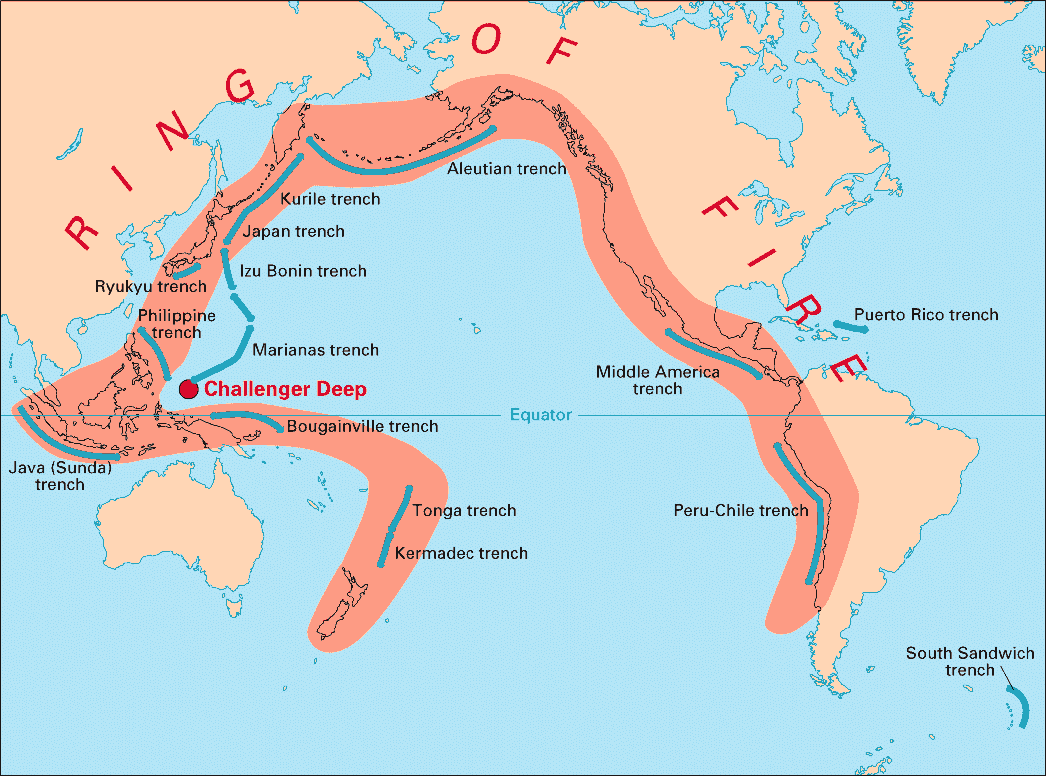Tsunami
The word ‘tsunami’ means ‘harbor wave’ in Japanese (tsu = harbor + nami = wave), reflecting Japan’s tsunami-prone history. Usually caused by earthquakes tsunamis of this nature have been known to reach heights of over 100 ft and travel at speeds of up to 500 miles per hour – almost as fast as a passenger airline. They are one of the most destructive forces in nature, and have claimed many lives and much destruction over human history.
Most tsunamis occur within a geographical area known as the ‘ring of fire’. The reason for this is that there are numerous earthquakes and volcanic eruptions within this area. The ‘ring of fire’ is a large 40,000 km – 25,000 mile – horseshoe-shaped area that encompasses most of the Pacific ocean. It contains a continuous series of ocean trenches, volcanic arcs and volcanic belts, has 452 volcanoes, and is home to 75% of the world’s active and dormant volcanoes. Around 90% of the world’s earthquakes and 81% of the world’s largest earthquakes occur within the ‘ring of fire’.
When a tsunami occurs it can travel across an entire ocean. In the deepest parts of the ocean a tsunami can be very small, sometimes only a few meters high, meaning that fishing boats and other vessels can sail over the top of a tsunami without even realising. However, tsunamis retain their energy, meaning that it is possible for them to cross entire oceans without loosing a single drop of force. Although Japan is highly prone to tsunamis, Hawaii is also a favourite destination for these huge waves. Hawaii is hit by a tsunami roughly once per year, and receives the full blow of a sever tsunami approximately every seven years. In order to place the power and possible destruction of these natural disasters into context: in 2004 there was an earthquake in the Indian Ocean that emitted the power of 23,000 atomic bombs. This caused numerous tsunamis that slammed into the coastline of eleven countries and killed 283,000 people.
As if the threat of a tsunami was not terrifying enough; there is also such a thing as a ‘mega tsunami’. As was stated earlier most tsunamis are caused by earthquakes, and due to the limited power of earthquakes tsunamis will usually only achieve a certain maximum size – approximately 100 ft. However, if a large landslide occurs then extremely large quantities of rock can fall from incredibly large heights into vast bodies of water with relentless force, and cause a mega tsunami. Mega tsunamis are very rare but they still happen more frequently that one would like to accept. On 9th July 1958 an earthquake with a magnitude of 7.7 – 8.3 caused 90 million tonnes of rock and ice to fall into the deep water of Lituya bay, USA. The impact from this collision was great enough to create a tsunami 1720 ft – 524 m – high. Howard Ulrich and his son witnessed the mega tsunami as they were sat in the bay in their fishing boat. I have no doubt it was with much apprehension that they watched this beyond gargantuan wave approach them, and carry them over the trees. Amazingly, they both lived to tell the tale. However, mega tsunamis are not only caused by large landslides, it is also possible for them to be created via asteroid impacts. Roughly 66 million years ago an asteroid collided with the earth, creating the Chicxulub crater in Yucatan. This collision was so grand scientists have calculated that a mega tsunami as high a 5 km – 3.1 miles – was created. A wave so large that it could consume an island as big a Madagascar without much difficulty. A wave so vast that even attempting to visualise its grandness is difficult.

The infamous ring of fire that contains 452 volcanoes and is the birthplace of 81% of the world’s largest earthquakes.

